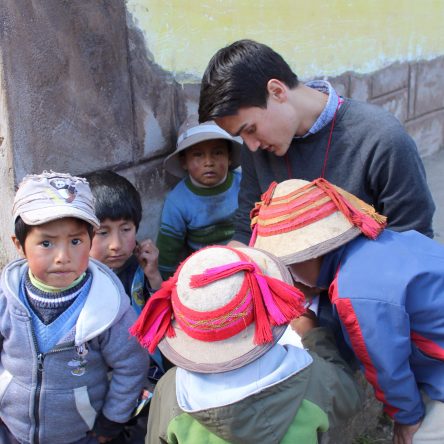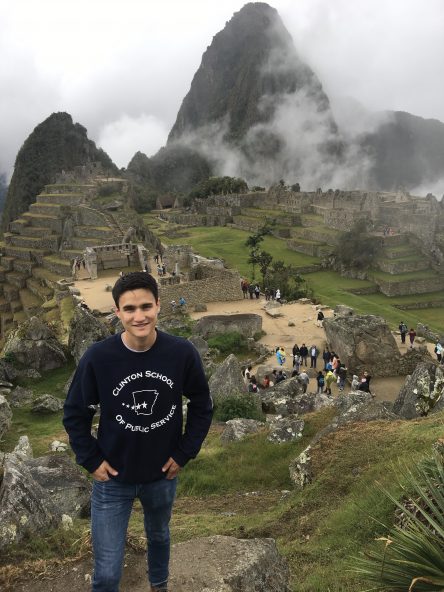Bowen student helps indigenous women in Peru start businesses
A University of Arkansas at Little Rock William H. Bowen School of Law student volunteered this summer with a nonprofit organization that helps indigenous women in Peru make money by starting their own businesses.
Brandon Treviño, who is also a concurrent student with the Clinton School of Public Service, recently completed his International Public Service Project (IPSP) in Peru.
Treviño worked with Awamaki, which helps women start and run their own businesses by investing in their skills and leadership and connecting them to global markets for their traditional hand-woven textiles.
What is the mission of Awamaki?
The mission of Awamaki is to increase the income for the indigenous women that live in Ollantaytambo and the Sacred Valley of Peru. Originally, when the organization I worked with started, they were involved in all services, and they decided that in order to be more effective, they should shift focus to a specific area where they excel.
They looked into what they were doing best, and realized that it was increasing income for women. They did this through the women’s traditional textiles and giving them access to global markets in order to increase their income.
What are some specific examples of how Awamaki invested in women and connected them with different markets?
One of the biggest things we did was create weaving centers in two of the communities that we worked with. A perfect example is how Awamaki takes the funds from volunteers paying to be there and reinvests some of those funds into building these centers.
Whether it’s through volunteers doing fundraising while they’re out there to get more money to invest back into the communities, or sales from the artisanal products, some of that money gets reinvested into the women to make the weaving centers.
These weaving centers are important because they provide the women with a centralized place to make products, collaborate on what products to sell, and explore how to make them better to sell, creating larger profits that go back into the community.
Also, one of the projects I did that exemplifies how Awamaki invests in the women was empowerment workshops. We would help the women become better business leaders in the communities, and help them establish how to make high-quality products that cater to our clientele. Those are just a couple ways on how Awamaki reinvests in these women and tries to get them connected to the markets.
What were the challenges of Awamaki that you didn’t expect?
There were aspects of it that I anticipated through working with a nonprofit in such a rural part of Peru. The communication sometimes is very slow. The pace of life is very slow. A concrete example is how my team and I were charged with doing demographic surveys of all the women, and sometimes we would set it up with the Peruvian staff in a certain community, and they would plan on doing the interviews and demographic surveys on certain days, but once the day of the interviews came, the women weren’t there because they had forgotten it was that day. So, they’d have to push it back a day or two. This is just an example of how the pace of life there is a lot different.
Even just finding vehicles or finding enough space to take all of us to these communities was hard at times. Those are just a few examples of how different challenges would present themselves in a way that I didn’t expect, but that’s the nature with a nonprofit in that area of the world.

How did you spend free time?
Free time was spent going on hikes and going to different communities. Ollantaytambo is located between Cusco and Machu Picchu, and there were so many cool things between those places. Cusco was awesome and a really cool city.
Machu Picchu was breathtaking and beautiful. On weekends, there were so many sites to see. Some of the things I enjoyed were the ancient Incan ruins, the salineras, which are salt mines you could visit, and free hikes all around Ollantaytambo.
I did one hike that lasted five hours. It was free, and it was up to the top of the mountain Inti Punko, which means sun gate in Quechua. We hiked up for five hours, then we came down and camped overnight, and it was just so fun.
There were so many cool things. There was even nightlife in the city called Urubamba. You could go there if you wanted to go to a disco techa, or find a really nice place to eat. Overall, there was a lot to do in Ollantaytambo.
How did this effect your long-term career goals?
I found out my niche probably isn’t in international global development. I was thinking about this a little before I left, that I could have the most impact in my own home and my own community. It’s not that I didn’t enjoy my time and I think that I could do it in the future, it just reassured me that my biggest impact would be at home where I have the most connections.
I noticed that the women who worked in my organization had the most effect on the women we worked with. They were Peruvian staff. They had personal connections with all the women, and kind of connected with them on a different level than I or some of the other volunteers could. I feel like they reacted better to the Peruvian staff who have the same experiences and speak the same language.
This made me realize that that’s the way I can be in my community; I can be a leader in my community. I think people respond more to people who share a connection with them. I feel like that can make a bigger impact. That’s not to say that people can’t have an impact internationally and in places where people need help, because that is still needed. Personally, it really solidified for me that I will probably have the strongest impact back home.
You are a concurrent student at the Bowen School of Law. How did this experience fit with that side of your education?
As far as being a law student and a master’s student, I wanted to supplement my law degree with something that was relevant to public service. I have always wanted to be in public service, whether that was nonprofit work or governmental work.
I knew I wanted to have more than just a law degree, and this was the perfect component for that. I feel like being a lawyer is a form of public service, especially if you’re trying to help others. I want to be the best public servant, whether that’s in law or other places, and I feel like the Clinton School has given me that extra education on how to be the most effective public servant.
Were there other aspects of the experience that stood out?
I had an overall positive experience. This is the perfect way to see your Clinton School work put to actual use in the field. Practicum is great, but after you’ve had that practicum experience and all the classes, when you go out and do your IPSP project, you really see how the Clinton School has led the way to a career in international development, or whatever area you want to do your project in. That was a cool experience for me.
I literally could tell you about specific skills from every class that I put to use in the field. In our field research methods class, we learned how to do interviews, surveys, and data collection. I did all of that with my surveys, and I did a couple of interviews. Also, when we talked about program planning and evaluation, we went over logic models and how to plan these programs. I set up empowerment workshops and created logic models for my organization to use after I left.
I used sustainability plans that I learned in our program planning class with Dr. Al Bavon, and I actually made those for my organization. Those are just two that I can think of. Even some soft skills that I learned through our global development class and other courses applied in the field. So that was really cool to see.
The article was written by Patrick Newton with the University of Arkansas Clinton School of Public Service. Photos provided by Amie Alexander.
